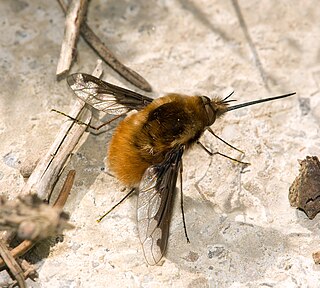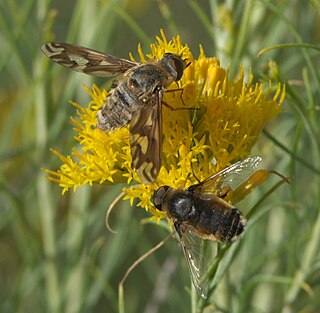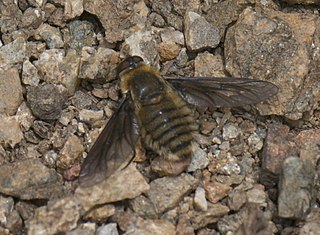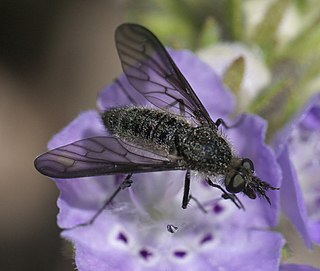
The Bombyliidae are a family of flies, commonly known as bee flies. Some are colloquially known as bomber flies. Adults generally feed on nectar and pollen, some being important pollinators. Larvae are mostly parasitoids of other insects.

Poecilanthrax willistonii, Williston's bee fly or sand dune bee fly, is a member of the Bombyliidae insect family. This family includes the bee flies, true flies that have developed Batesian mimicry characteristics to avoid predators. That is, they look like bees because that helps them avoid bee-wary predators, but they lack stingers.

Ligyra is a genus of bee flies in the Bombyliidae family. It was described by Edward Newman in 1841. There are at least 110 described species in Ligyra.

Anthracinae is a subfamily of bee flies in the family Bombyliidae. There are more than 80 genera and 2,000 described species in Anthracinae.
Bombylius albicapillus is a species of bee fly in the family Bombyliidae. It occurs in western North America.
Exoprosopa parda is a species of bee fly in the family Bombyliidae.

Poecilanthrax monticola is a species of bee fly in the family Bombyliidae. It is found in North America, from British Columbia and Alberta south to Nebraska, Utah, and Colorado.

Villini is a tribe of bee flies in the family Bombyliidae.

Thevenetimyia luctifera is a species of bee fly in the family Bombyliidae. It is found in western North America from Mexico north to British Columbia, Canada, and as far east as Colorado in the United States.

Thevenetimyia speciosa is a species of bee fly in the family Bombyliidae. It is known from Arizona.

Aldrichia is a North American genus of bee flies in the family Bombyliidae. The genus contains two described species.
Bombylius pulchellus is a species of bee flies in the family Bombyliidae. It is found in Canada from Alberta east to Quebec and in the northern United States from Nebraska to Maryland.
Lepidanthrax eremicus is a species of bee fly in the family Bombyliidae. It is known from California.
Rhynchanthrax is a North American genus of bee flies in the family Bombyliidae. There are seven described species in Rhynchanthrax.
Ogcodocera analis is a species of bee fly in the family Bombyliidae. It is found in Mexico, Arizona, and Texas.
Ogcodocera is a North American genus of bee flies in the family Bombyliidae. There are two described species in the genus Ogcodocera.
Lepidanthrax californicus is a species of bee fly in the family Bombyliidae. It is known from California, Arizona, and Baja California Norte.

Geron is a genus of bee flies in the family Bombyliidae. There are at least 180 described species in the genus Geron, found on every continent except Antarctica.
Rhynchanthrax capreus is a species of bee fly in the family Bombyliidae. It is found in Mexico and the southwestern United States from California to Nebraska.
Paradiplocampta is a genus of bee flies in the family Bombyliidae. There is one described species in the genus Paradiplocampta, P. tabeti, known from California and Arizona.









